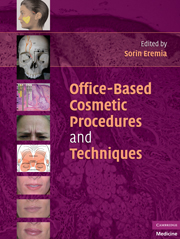Book contents
- Frontmatter
- Contents
- PREFACE
- CONTRIBUTORS
- PART ONE ANATOMY AND THE AGING PROCESS
- PART TWO ANESTHESIA AND SEDATION FOR OFFICE COSMETIC PROCEDURES
- PART THREE FILLERS AND NEUROTOXINS
- PART FOUR COSMETIC APPLICATIONS OF LIGHT, RADIOFREQUENCY, AND ULTRASOUND ENERGY
- Chap. 42 TREATMENT OF TELANGIECTASIA, POIKILODERMA, AND FACE AND LEG VEINS
- Chap. 43 VASCULAR LASERS
- Chap. 44 OVERVIEW OF CO2 AND ER:YAG LASERS AND PLASMA DEVICES
- Chap. 45 CONTEMPORARY CO2 LASER RESURFACING
- Chap. 46 ER:YAG
- Chap. 47 PLASMA SKIN REJUVENATION OF THE HANDS
- Chap. 48 NONABLATIVE LASER TISSUE REMODELING: 1,064-, 1,320-, 1,450-, AND 1,540-NM LASER SYSTEMS
- Chap. 49 OVERVIEW OF BROADBAND LIGHT DEVICES
- Chap. 50 TITAN: INDUCING DERMAL CONTRACTION
- Chap. 51 SCITON BROADBAND LIGHT AND ER:YAG MICROPEEL COMBINATION
- Chap. 52 AMINOLEVULINIC ACID PHOTODYNAMIC THERAPY FOR FACIAL REJUVENATION AND ACNE
- Chap. 53 THERMAGE FOR FACE AND BODY
- Chap. 54 LUMENIS ALUMA SKIN TIGHTENING SYSTEM
- Chap. 55 ELLMAN RADIOFREQUENCY DEVICE FOR SKIN TIGHTENING
- Chap. 56 ALMA ACCENT DUAL RADIOFREQUENCY DEVICE FOR TISSUE CONTOURING
- Chap. 57 COMBINED LIGHT AND BIPOLAR RADIOFREQUENCY
- Chap. 58 FRACTIONAL LASERS: GENERAL CONCEPTS
- Chap. 59 PALOMAR LUX 1,540-NM FRACTIONAL LASER
- Chap. 60 FRAXEL 1,550-NM LASER (FRAXEL RE:STORE)
- Chap. 61 1,440-NM FRACTIONAL LASER: CYNOSURE AFFIRM
- Chap. 62 SCITON ER:YAG 2,940-NM FRACTIONAL LASER
- Chap. 63 ALMA PIXEL ER:YAG FRACTIONAL LASER
- Chap. 64 FRACTIONATED CO2 LASER
- Chap. 65 LED PHOTOREJUVENATION DEVICES
- Chap. 66 PHOTOPNEUMATIC THERAPY
- Chap. 67 HAIR REMOVAL: LASER AND BROADBAND LIGHT DEVICES
- Chap. 68 ACNE AND ACNE SCARS: LASER AND LIGHT TREATMENTS
- Chap. 69 FAT AND CELLULITE REDUCTION: GENERAL PRINCIPLES
- Chap. 70 ULTRASHAPE FOCUSED ULTRASOUND FAT REDUCTION DEVICE
- Chap. 71 LIPOSONIX ULTRASOUND DEVICE FOR BODY SCULPTING
- PART FIVE OTHER PROCEDURES
- INDEX
- References
Chap. 47 - PLASMA SKIN REJUVENATION OF THE HANDS
from PART FOUR - COSMETIC APPLICATIONS OF LIGHT, RADIOFREQUENCY, AND ULTRASOUND ENERGY
Published online by Cambridge University Press: 06 July 2010
- Frontmatter
- Contents
- PREFACE
- CONTRIBUTORS
- PART ONE ANATOMY AND THE AGING PROCESS
- PART TWO ANESTHESIA AND SEDATION FOR OFFICE COSMETIC PROCEDURES
- PART THREE FILLERS AND NEUROTOXINS
- PART FOUR COSMETIC APPLICATIONS OF LIGHT, RADIOFREQUENCY, AND ULTRASOUND ENERGY
- Chap. 42 TREATMENT OF TELANGIECTASIA, POIKILODERMA, AND FACE AND LEG VEINS
- Chap. 43 VASCULAR LASERS
- Chap. 44 OVERVIEW OF CO2 AND ER:YAG LASERS AND PLASMA DEVICES
- Chap. 45 CONTEMPORARY CO2 LASER RESURFACING
- Chap. 46 ER:YAG
- Chap. 47 PLASMA SKIN REJUVENATION OF THE HANDS
- Chap. 48 NONABLATIVE LASER TISSUE REMODELING: 1,064-, 1,320-, 1,450-, AND 1,540-NM LASER SYSTEMS
- Chap. 49 OVERVIEW OF BROADBAND LIGHT DEVICES
- Chap. 50 TITAN: INDUCING DERMAL CONTRACTION
- Chap. 51 SCITON BROADBAND LIGHT AND ER:YAG MICROPEEL COMBINATION
- Chap. 52 AMINOLEVULINIC ACID PHOTODYNAMIC THERAPY FOR FACIAL REJUVENATION AND ACNE
- Chap. 53 THERMAGE FOR FACE AND BODY
- Chap. 54 LUMENIS ALUMA SKIN TIGHTENING SYSTEM
- Chap. 55 ELLMAN RADIOFREQUENCY DEVICE FOR SKIN TIGHTENING
- Chap. 56 ALMA ACCENT DUAL RADIOFREQUENCY DEVICE FOR TISSUE CONTOURING
- Chap. 57 COMBINED LIGHT AND BIPOLAR RADIOFREQUENCY
- Chap. 58 FRACTIONAL LASERS: GENERAL CONCEPTS
- Chap. 59 PALOMAR LUX 1,540-NM FRACTIONAL LASER
- Chap. 60 FRAXEL 1,550-NM LASER (FRAXEL RE:STORE)
- Chap. 61 1,440-NM FRACTIONAL LASER: CYNOSURE AFFIRM
- Chap. 62 SCITON ER:YAG 2,940-NM FRACTIONAL LASER
- Chap. 63 ALMA PIXEL ER:YAG FRACTIONAL LASER
- Chap. 64 FRACTIONATED CO2 LASER
- Chap. 65 LED PHOTOREJUVENATION DEVICES
- Chap. 66 PHOTOPNEUMATIC THERAPY
- Chap. 67 HAIR REMOVAL: LASER AND BROADBAND LIGHT DEVICES
- Chap. 68 ACNE AND ACNE SCARS: LASER AND LIGHT TREATMENTS
- Chap. 69 FAT AND CELLULITE REDUCTION: GENERAL PRINCIPLES
- Chap. 70 ULTRASHAPE FOCUSED ULTRASOUND FAT REDUCTION DEVICE
- Chap. 71 LIPOSONIX ULTRASOUND DEVICE FOR BODY SCULPTING
- PART FIVE OTHER PROCEDURES
- INDEX
- References
Summary
Photodamaged skin of the hands occurs as a result of chronic exposure to ultraviolet light and is characterized by roughened surface texture, dyspigmentation, telangiectasias, rhytids, and skin laxity. Although several different noninvasive procedures have been advocated for hand rejuvenation (Table 47.1), many are characterized by an unattainable balance between effectiveness and morbidity. The necessity of epidermal removal during most skin resurfacing treatments leads to significant morbidity during the reepithelialization process, particularly in areas such as the hands, where limited pilosebaceous glands are present.
Plasma skin regeneration Technology
Plasma skin regeneration is a novel process that involves the generation of plasma through the use of ionized energy that thermally heats tissue. A pulse of ultrahigh-energy radio-frequency (RF) from the device generator (Portrait plasma skin regeneration) converts nitrogen gas into plasma within the handpiece. The plasma emerges from the distal end of the device handpiece and is directed onto the skin area to be treated. Rapid heating of the skin occurs as the excited gas transfers heat to the skin, resulting in increased fibroblast activity during dermal regeneration. The retained necrotic epidermis effectively serves as a biological dressing for the efficient formation of a new stratum corneum and epidermis.
The essentially instantaneous generation of plasma with controlled application of RF energy produces individual plasma pulses that heat tissue. Adjustment of RF power and pulse width enables control of tissue effects by altering the amount of energy delivered to tissue per pulse.
- Type
- Chapter
- Information
- Office-Based Cosmetic Procedures and Techniques , pp. 218 - 220Publisher: Cambridge University PressPrint publication year: 2010



